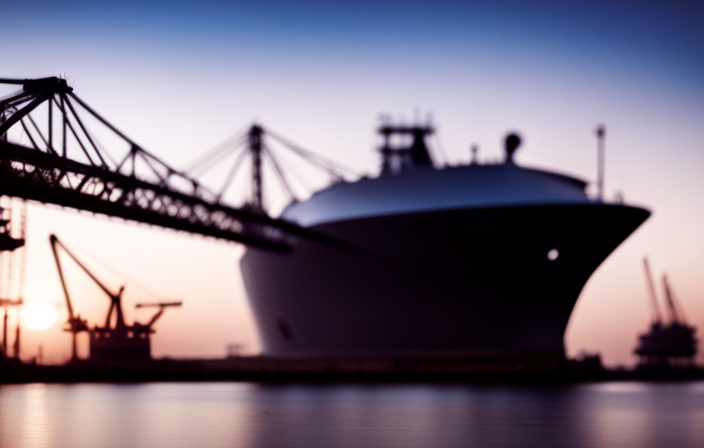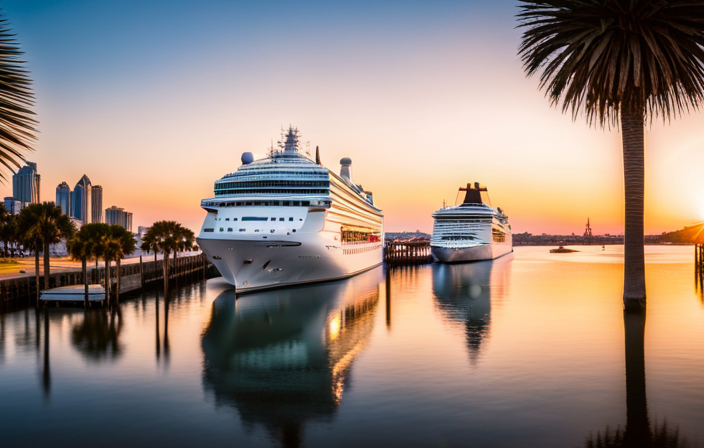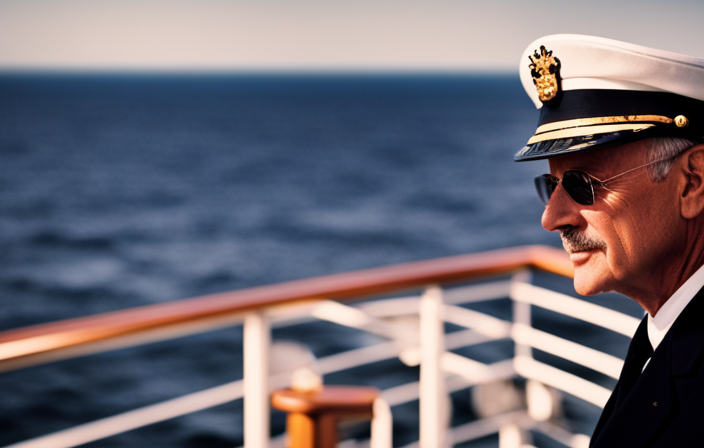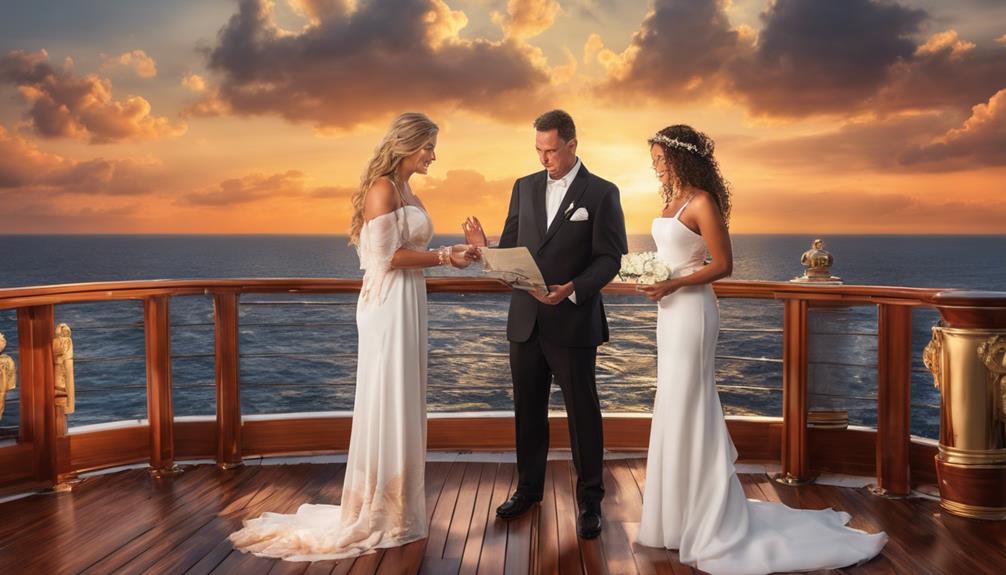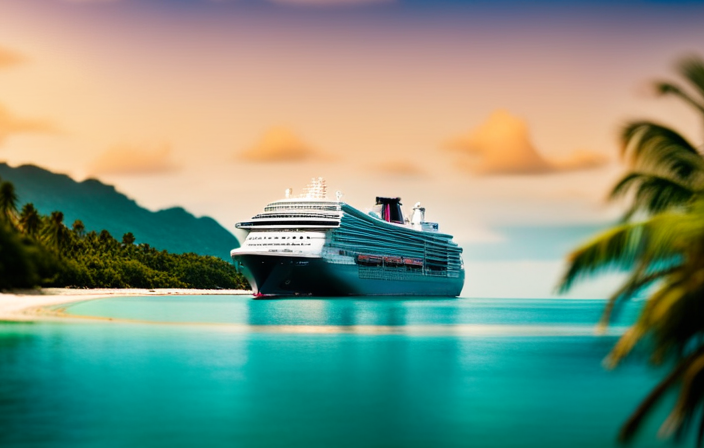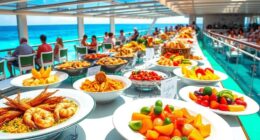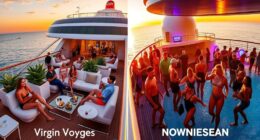Ever thought about how those massive floating cities, better known as cruise ships, come to life? Join me on a journey to explore the fascinating process of their construction. From the initial design phase to the final unveiling and delivery, each step is carefully planned and carried out to bring these engineering wonders to life.
First, the ship’s design is carefully crafted, taking into account factors like passenger capacity, amenities, and safety features. Then comes the procurement of materials – steel for the sturdy hull and superstructure, specialized materials for insulation and fire resistance.
Next up is the structural construction – where skilled workers assemble the various sections of the ship piece by piece. Once complete, interior designers step in to transform these bare bones into luxurious cabins, elegant dining areas, and entertainment facilities that rival those found on land.
Mechanical and electrical systems are then installed with precision, ensuring everything from propulsion to air conditioning runs smoothly. Finally, after rigorous inspections and certifications are obtained, it’s time for these floating giants to be launched into their natural habitat – the open sea.
So buckle up as we dive deep into this fascinating world of cruise ship construction!
Key Takeaways
- The construction of a cruise ship involves initial design and planning stages, material selection and procurement, structural construction, interior design and furnishing, installation of mechanical and electrical systems, testing and quality control, and project management challenges.
- Material sourcing considerations include evaluating quality, availability, cost, sustainability, and compatibility. Common materials used in cruise ship construction are steel, aluminum, and fiberglass.
- Innovative construction methods like modular assembly and the use of advanced materials such as high-strength steel alloys are employed to ensure precision, reduce construction time, and enhance the overall experience for passengers.
- Sustainability is an important aspect of cruise ship construction, with considerations for environmentally-friendly options, sustainable furnishing materials, energy-saving technologies, and the use of alternative fuels like liquefied natural gas (LNG) and solar panels for auxiliary power generation.
Initial Design and Planning Stages
The initial design and planning stages of cruise ship construction involve a meticulous process. Various engineering and architectural elements are carefully considered and incorporated into the final blueprint.
During these stages, initial design considerations such as size, capacity, and functionality are taken into account. This ensures the ship meets the specific requirements of the cruise line.
Project management challenges arise in coordinating different teams responsible for designing various aspects of the ship. These include propulsion systems, electrical systems, and interior spaces.
Safety regulations and environmental concerns must also be addressed during this stage.
Once the initial design is finalized, material selection and procurement can begin to bring the blueprint to life.
Material Selection and Procurement
To ensure strength and durability, I carefully select and acquire various materials for the construction of cruise ships. Materials such as steel, aluminum, and fiberglass are vital in creating a reliable vessel.
Did you know that a typical cruise ship can require up to 50,000 tons of steel? Sourcing considerations and supply chain management play crucial roles in this process.
Here are some factors to consider when sourcing materials:
- Quality: Ensuring that the materials meet industry standards.
- Availability: Identifying suppliers who can provide the required quantities within the given timeframe.
- Cost: Evaluating prices to maintain project budget constraints.
- Sustainability: Considering environmentally-friendly options to minimize the ecological impact.
- Compatibility: Selecting materials that are compatible with other components.
Careful material selection sets the foundation for successful structural construction.
Structural Construction
When constructing a cruise ship, I carefully oversee the structural construction process to ensure strength and durability. The structural design of the ship is crucial for its overall performance and safety at sea.
Various construction techniques are employed to create a robust and reliable vessel. One important aspect of the structural construction is the use of advanced materials such as high-strength steel alloys that can withstand the harsh marine environment. These materials are carefully selected for their strength, corrosion resistance, and weight-saving properties.
Additionally, innovative construction methods like modular assembly are used to efficiently build large sections of the ship in controlled environments before being transported to the final site for integration. This ensures precision and reduces construction time.
Moving forward into ‘interior design and furnishing’, attention shifts from building structure to creating luxurious amenities that will enhance passengers’ experience onboard.
Interior Design and Furnishing
Crafting an exquisite and inviting atmosphere within the vessel’s interiors elevates the overall experience for passengers on board. Interior design trends play a crucial role in creating a luxurious and comfortable environment. These trends often include modern, minimalist designs with clean lines, vibrant color schemes, and innovative lighting solutions. Sustainable furnishing options are also becoming increasingly popular, with cruise ship designers opting for eco-friendly materials such as recycled wood, low VOC paints, and energy-efficient lighting fixtures.
To give you a better understanding of the interior design process, here is a table showcasing some key elements that are carefully considered during the construction phase:
| Element | Description |
|---|---|
| Color scheme | Carefully chosen colors to create a specific ambiance |
| Furniture selection | High-quality pieces that provide both comfort and style |
| Flooring | Durable materials that withstand heavy foot traffic |
| Lighting | Well-placed fixtures to enhance mood and highlight key areas |
| Wall coverings | Textured wallpapers or decorative panels for added visual interest |
With the interior design completed, attention then shifts to the installation of mechanical and electrical systems. This ensures seamless operation throughout the ship without compromising on aesthetics.
Installation of Mechanical and Electrical Systems
Once the designers work their magic, the installation of mind-bogglingly complex mechanical and electrical systems turns the vessel into a technological marvel that would make even Tony Stark jealous. These systems are meticulously designed to ensure optimal functionality, energy efficiency, and sustainability onboard cruise ships.
-
Mechanical Systems:
The heart of these systems is the propulsion system, which includes engines, propellers, and fuel tanks. Additionally, ventilation and air conditioning systems provide comfortable living spaces for passengers and crew. Advanced plumbing and sewage systems handle waste management efficiently. -
Electrical Systems:
Cruise ships require an extensive network of electrical power generation and distribution. This includes generators, transformers, switchboards, and cabling to supply electricity throughout the ship. Lighting fixtures utilize energy-efficient LED technology to minimize power consumption. -
Energy Efficiency and Sustainability:
Cruise ships incorporate various measures to reduce their environmental impact. These include using advanced wastewater treatment systems, employing alternative fuels like liquefied natural gas (LNG), implementing energy-saving technologies such as heat recovery systems, and utilizing solar panels for auxiliary power generation.
As these intricate installations near completion, meticulous testing and quality control procedures ensure that everything operates flawlessly before embarking on its maiden voyage.
Testing and Quality Control
To ensure the flawless operation of these intricate installations, meticulous testing and quality control procedures are implemented to guarantee optimal functionality before setting sail on its maiden voyage. Testing procedures involve a comprehensive examination of the mechanical and electrical systems to identify any potential issues or malfunctions. This includes conducting performance tests, such as load testing for engines and generators, as well as functional tests for air conditioning, plumbing, and lighting systems. Quality assurance measures are also taken to ensure that all components meet industry standards and regulations. Through rigorous inspections and audits, any defects or discrepancies are identified and rectified promptly. Additionally, a 2 column by 5 row table can be used to track test results, including system specifications, test parameters, observed performance levels, acceptance criteria, and final outcomes. By implementing these thorough testing and quality control processes, cruise ship builders can confidently proceed with the subsequent section about painting and exterior finishing.
Painting and Exterior Finishing
When it comes to painting and exterior finishing on cruise ships, there are two main aspects that require attention:
-
Applying protective coatings and paints: Protective coatings play a crucial role in safeguarding the ship’s hull from corrosion caused by saltwater exposure. Carefully applying high-quality paints not only enhances the aesthetic appeal of the vessel but also helps protect it against harsh weather conditions and UV radiation.
-
Adding exterior features like balconies and promenade decks: Incorporating features like balconies and promenade decks provide passengers with opportunities for relaxation and enjoyment while at sea.
These two aspects are essential for maintaining the ship’s appearance and ensuring the safety and comfort of passengers.
Applying Protective Coatings and Paints
Cruise ships are constructed using protective coatings and paints to ensure their longevity and enhance their aesthetic appeal as well.
Different types of protective coatings are applied during the construction process to protect the ship’s exterior from corrosion, UV radiation, and other environmental factors. These coatings include anti-fouling paints, which prevent marine organisms from attaching to the hull and causing damage.
The application process involves thorough surface preparation, including cleaning and sanding, to create a smooth base for the coatings. Then, multiple layers of protective coatings are carefully applied using specialized equipment such as spray guns or rollers. Each layer must be allowed to dry properly before applying the next one.
Once the protective coatings are in place, attention is turned towards adding exterior features like balconies and promenade decks seamlessly into the ship’s design without compromising its structural integrity or functionality.
Adding Exterior Features like Balconies and Promenade Decks
As you explore the construction process of a cruise ship, envision how exterior features like balconies and promenade decks seamlessly meld into the ship’s design, enhancing its allure without compromising its structural integrity or functionality. These exterior features are meticulously designed to provide passengers with optimal comfort and breathtaking views while maintaining utmost safety.
-
Balcony designs: Cruise ships offer various types of balcony designs, including private balconies for individual cabins and larger public balconies for common areas. Each design is carefully crafted to maximize space utilization and ensure privacy for passengers.
-
Promenade deck construction: The promenade deck is a popular feature on cruise ships, providing an open-air walking area that encircles the ship. It is constructed using durable materials that withstand harsh weather conditions at sea while offering stunning panoramic views.
-
Luxurious amenities: The balconies are adorned with luxurious amenities such as comfortable seating arrangements, decorative elements, and stylish railings to create an elegant ambiance for passengers.
-
Safety measures: Special attention is given to safety during the construction of these exterior features. Reinforced materials and sturdy barriers are incorporated to prevent accidents and ensure passenger well-being.
As we move into the next section about the installation of amenities and entertainment facilities onboard, it becomes evident how these exterior features contribute to creating a truly unforgettable cruising experience without compromising on safety or structural integrity.
Installation of Amenities and Entertainment Facilities
To truly experience the grandeur of a cruise ship, you’ll be amazed at how seamlessly amenities and entertainment facilities are integrated into the design. The planning of amenities involves careful consideration of passenger needs and desires. From luxurious spas and fitness centers to sprawling casinos and theaters, every aspect is meticulously designed to provide an unforgettable experience. Entertainment facilities are strategically located throughout the ship, ensuring that passengers can easily access a variety of options. To illustrate this integration, consider the following table:
| Location | Facility | Description |
|---|---|---|
| Deck 5 | Main Theater | State-of-the-art venue for Broadway-style shows |
| Deck 10 | Poolside Bar | Outdoor bar with live music and stunning views |
| Deck 12 | Spa & Wellness Center | Oasis of relaxation offering massages, saunas, and beauty treatments |
As construction progresses, these amenities and entertainment facilities are installed in their designated areas. Once completed, final inspections and certifications ensure that everything meets strict safety regulations before passengers embark on their remarkable journey through the seas.
Final Inspections and Certifications
To ensure compliance with safety and environmental regulations, cruise ships undergo final inspections and certifications. These inspections are conducted by classification societies. These societies are responsible for evaluating the ship’s construction materials, equipment, systems, and safety features. The purpose of these certifications is to verify that the ship meets all necessary standards and requirements before it can be put into service.
Ensuring Compliance with Safety and Environmental Regulations
Cruise ships are meticulously constructed to ensure strict compliance with safety and environmental regulations. Numerous safety measures are implemented during the construction process to guarantee the well-being of passengers and crew members. This includes the installation of advanced fire detection and suppression systems, emergency evacuation procedures, and structural integrity assessments.
Environmental impact is also a key consideration in cruise ship construction. Efforts are made to minimize emissions by incorporating innovative technologies such as scrubbers for air pollution control and wastewater treatment systems. Sustainable materials are used whenever possible to reduce the ecological footprint of the vessel.
As construction nears completion, comprehensive inspections are conducted by regulatory bodies to ensure compliance with these rigorous standards. Certifications from classification societies are obtained to attest to the ship’s adherence to safety and environmental requirements.
Obtaining Certifications from Classification Societies
Once the meticulous construction process is completed, you can rest assured that the vessel has undergone rigorous inspections by regulatory bodies to obtain certifications from classification societies. These certifications ensure the vessel’s adherence to safety and environmental requirements.
The certification process involves several stages. It starts with a thorough examination of the ship’s design plans and specifications. This initial assessment ensures that the vessel meets all relevant regulatory requirements before construction begins.
Once construction is underway, regular inspections are conducted at various stages to verify compliance with safety standards and environmental regulations. These inspections cover different aspects such as structural integrity, fire safety measures, pollution prevention systems, and emergency response capabilities.
Only after successfully passing these inspections can a cruise ship receive the necessary certifications from classification societies. With these certifications in place, the vessel is ready for launch and delivery to its eagerly awaiting owners.
Transitioning into the subsequent section about ‘launch and delivery’, we move on to the final phase of the cruise ship’s journey from blueprint to reality.
Launch and Delivery
When it comes to launching and delivering a cruise ship, there are two key points that need to be addressed.
The first is floating the ship for the first time, which involves carefully releasing it into the water for the very first time. This process requires a great deal of precision and expertise to ensure that everything goes smoothly.
Once the ship has been successfully floated, the next step is delivering it to the cruise line or owner. This involves navigating through various waterways and making sure all systems are fully functional before handing over control of the vessel.
Floating the Ship for the First Time
To witness the ship floating for the first time, simply marvel at the culmination of meticulous craftsmanship and engineering expertise.
The floating process begins with water testing, where the ship is carefully positioned in a dry dock and filled with water. This allows for a thorough examination of its buoyancy and stability. During this critical phase, engineers closely monitor every aspect to ensure that the ship meets all safety standards.
Once the tests are successfully completed, it’s time to deliver the ship to the cruise line or owner. The next step involves preparing the vessel for its maiden voyage, including outfitting it with luxurious amenities and state-of-the-art facilities.
From there, passengers will embark on unforgettable journeys across vast oceans and breathtaking destinations.
Delivering the Ship to the Cruise Line or Owner
Delivering a cruise ship to its final destination involves several challenges and intricate transportation logistics. Once construction is complete and all necessary inspections have been carried out, the ship must be transported from the shipyard to the designated port or dock where it will embark on its maiden voyage.
This process requires careful planning and coordination with various stakeholders, including tugboat operators, pilotage services, and port authorities. The sheer size and weight of a cruise ship present significant logistical challenges, such as selecting appropriate routes that can accommodate its dimensions and ensuring safe passage through narrow waterways or under low bridges.
Additionally, weather conditions must be closely monitored to ensure smooth sailing during transport. Despite these challenges, delivering a cruise ship marks an exciting milestone in its journey towards providing unforgettable experiences for passengers around the world.
Frequently Asked Questions
How long does it typically take to build a cruise ship from start to finish?
It typically takes several years to build a cruise ship from start to finish. The construction timeline varies depending on the size and complexity of the vessel, as well as the availability of resources and workforce. The construction process involves designing, engineering, and constructing various sections of the ship before they are assembled together.
What are the main challenges faced during the construction of a cruise ship?
During the construction process of a cruise ship, challenges are faced. These include managing complex engineering tasks, coordinating various teams and suppliers, ensuring safety compliance, and meeting strict deadlines for completion.
How are the various amenities and entertainment facilities chosen for installation on a cruise ship?
In the selection process for amenities and entertainment facilities on a cruise ship, various design considerations are taken into account. Factors such as passenger preferences, space availability, safety regulations, and operational efficiency play a vital role in determining which installations make the cut.
What measures are taken to ensure the safety and security of passengers during the construction process?
During the construction process, safety measures are implemented to protect passengers. This includes installing fire suppression systems, implementing emergency evacuation plans, and conducting thorough inspections to ensure structural integrity. Security measures are also put in place to prevent unauthorized access and protect against potential threats.
How much does it cost to build a cruise ship on average?
On average, the cost breakdown for building a cruise ship includes materials, labor, and equipment expenses. Financing options can vary depending on the shipyard’s policies and agreements with financial institutions.
Conclusion
In conclusion, the construction of cruise ships is an intricate process that requires meticulous planning, skilled craftsmanship, and attention to detail.
From the initial design stages to the final inspections and certifications, every step is carefully executed to ensure a top-quality vessel.
Like a well-oiled machine, each component fits seamlessly together, creating a floating paradise for travelers.
Building a cruise ship is truly a labor of love, where the idiom ‘building something from the ground up’ comes alive as steel transforms into magnificent floating cities on the sea.

